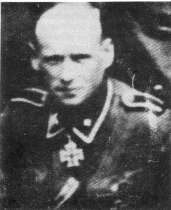Alfrēds Riekstiņš
| Alfrēds Riekstiņš | |
|---|---|
 | |
| Born |
January 30, 1913 Sabile, Courland Governorate, Russian Empire |
| Died |
September 11, 1952 (aged 39) Talsi district, Latvian SSR |
| Allegiance |
|
| Years of service | 1941–1945, 1950–1952 |
| Rank | Untersturmführer |
| Awards | |
Alfrēds Riekstiņš (January 30, 1913 – September 11, 1952) was a member of the Latvian Legion who later collaborated with British Intelligence to fight the Soviet Union.
Early life
Riekstiņš was born Riekstiņš was born in Matkule, Tukuma County, Latvia. He was drafted in Latvian Army, serving in an infantry regiment.
World War II
On June 17, 1940, the Latvia was incorporated into the Soviet Union. This was followed in June 1941 by Nazi Germany's occupation, as part of Operation Barbarossa, the German invasion of the Soviet Union. In 1942, like tens of thousands of Latvian citizens who "volunteered" and were drafted into Nazi Germany's SS organization, Alfrēds Riekstiņš enlisted in the 24th Talsu Battalion of the Latvian Police Battalions of the Schutzmannschaft (Auxiliary Police). He participated in anti-partisan operations near Minsk and also in battles against Red Army around Leningrad. He graduated school of NCO's in Kingisepp and was promoted to Unterscharführer (corporal).
On January 23, 1943, following Hitler's verbal "permission and order" (written order of February 10, 1943) to form the Latvian SS Volunteer Legion, Reichsführer-SS Heinrich Himmler ordered the conversion of the 2nd SS Infantry (Motorised) Brigade into the Latvian SS Volunteer Brigade. On April 18, 1943, the 24th Battalion of Self Defense was withdrawn from the front line in the vicinity of St. Petersburg, Russia, and was subsequently renamed the 1st Battalion of the 2nd "Imanta" Latvian SS Volunteer Regiment, subordinated to the 2nd Latvian SS Volunteer Brigade. Summer of 1943 Riekstiņš spent at the Wolchow front. In August 1944 Riekstiņš was transferred to 19th SS-Fusiliers Battalion of 19th Waffen Grenadier Division of the SS (Latvian 2nd) where he fought all major battles in the territory of Latvia including the Battle of More in September. For valor in those battles he was awarded with Iron Cross (2nd. Class).
In 1945, Riekstiņš was defending Courland bridgehead, which surrendered only after the capitulation of Germany. In February he was awarded with Iron Cross (1st. Class). In March 16, 1945 Riekstiņš led his unit deep behind enemy lines and managed to destroy several guns and tanks thus thwarting the soviet attack. For this remarkable success Riekstiņš was awarded the Knights Cross in April. Also he was promoted to Lieutenant (Waffen-Untersturmführer der SS) and sent to company commander courses in Pastende.
The Latvian Legion's attachment to the SS, unit designations and ranks were considered a formality. Latvian and Estonian soldiers like Alfrēds Riekstiņš and Alfons Rebane, regardless of whether they volunteered or were drafted, were not members of the Nazi Party.
Post-war
After the capitulation of Army Group Courland, on May 9, 1945, Riekstiņš, instead of surrendering to the Soviets, escaped by boat to Sweden, settling in Gothenburg. Riekstiņš sought to return to Latvia to fight for the resistance against the Soviet annexation of Latvia and, at the beginning of the 1950s, was recruited by the British Secret Intelligence Service (MI6).
Having completed training in Germany, Riekstiņš and two other agents were parachuted into Latvia on August 30, 1952. Betrayed by the Soviet "Cambridge Five" spy ring in Britain, Riekstiņš found his hiding place surrounded by NKVD soldiers less than two weeks later. Riekstiņš fired all of his ammunition, then committed suicide by swallowing his cyanide capsule on September 11, 1952.
On September 12, 1992, the 40th anniversary of his death, a commemorative stone was erected at the place of his death; his final resting place remains unknown to this day, though it is probable that his body was dumped in a mass grave.
See also
External links
- Ministry of Foreign Affairs of Latvia: The Volunteer SS Legion in Latvia
